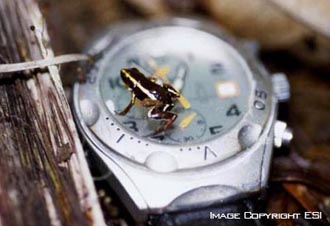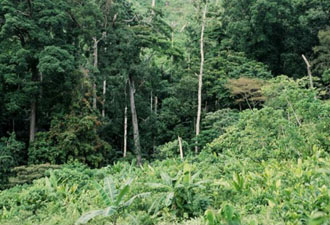The smallest frog in the world has no English common name yet.
Its scientific name is Eleutherodactylus iberia.
It has a snout vent length (SVL) of only 9.80 millimeters (mm) for males and 10.5 mm for females
(Estrada and Hedges 1996), which is smaller than a U.S. dime.
Its known range extends less than 100 km?, from fewer than five locations within forest habitat of the
Holguin Province, in Southern Cuba. This very rare frog is found in primary and secondary forest.
The region where it lives received high rainfall and is generally very humid.
Anurans of the genus Eleutherodactylus are generally terrestrial breeders with direct development.
E. iberia occupies the leaf litter floor of the tropical forest.
It is found under dense litter and roots where organic decomposition occurs.
Numerous species of tiny insects provide prey items for E. iberia.
It was collected and described for the first time in 1993 (Estrada and Hedges 1996). E. iberia is classified as critically endangered (IUCN 2003), and very little is known on its distribution and natural history.
Threats
In Cuba, most amphibian species have declined substantially because of deforestation and loss of habitat. Cuba has still the highest percentage of forest cover in the West Indies (World Resource Institute 1992), however, the percentage cover is relatively low (about 20%) and primary forest is scarce. Known threats include illegal deforestation, mining, and tourist development.
Research and Conservation Needs
The smallest frog of the world is found within the Alejandro Humbold National Park, which gives this species some protection. However, research on distribution, habitat association, natural history of this frog is urgently needed to address this species conservation needs. A monitoring program should be implemented to assess population trends.
Literature
Estrada, A.R. and Hedges, S.B. 1996. At the lower size limit in tetrapods: a new diminutive frog from Cuba (Leptodactylidae: Eleutherodactylus). Copeia. 1996:852-859.
IUCN. 2003. The 2003 IUCN Red List of Threatened Species. Gland:IUCN. http://www.redlist.org
IUCN, Conservation International, and NatureServe. 2004. Global Amphibian Assessment.
Global Amphibians Downloaded on 15 October 2004
Hedges, S.B. 1993. Global amphibian declines: a perspective from the Caribbean. Biodiversity and Conservation. 2:290-303.
Hedges, S.B. 1999. Distribution of amphibians in the West Indies. Patterns of Distribution of Amphibians. A Global Perspective. Duellman, W.E.,editor. The Johns Hopkins Press. Baltimore, Maryland.
Hedges, S.B. 2001. Caribherp: database of West Indian amphibians and reptiles (http://www.caribherp.net). Pennsylvania State University. University Park, PA.
Henderson, R.W. and Powell, R 1999. West Indian herpetoecology. Caribbean Amphibians and Reptiles. Crother, B.I.,editor. 223-226. Academic Press. San Diego, California.
Henderson, R.W. and Powell, R. 2001. Responses by the West Indian herpetofauna to human-influenced resources. Caribbean Journal of Science. 37:41-54.
Schwartz, A. and Henderson, R.W. 1991. Amphibians and Reptiles of the West Indies: Descriptions, Distributions and Natural History. University of Florida Press. Gainesville, Florida. xvi + 720 pp.
|
|


 Habitat of the world's smallest frog.
Habitat of the world's smallest frog.
|









